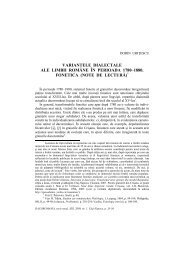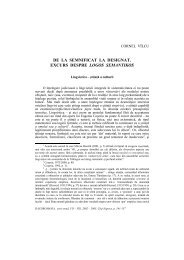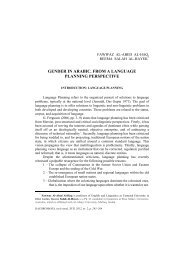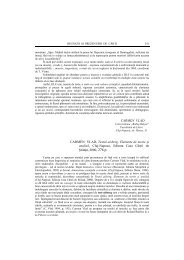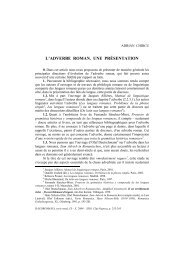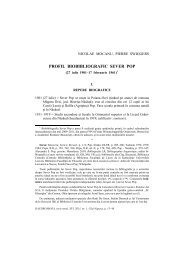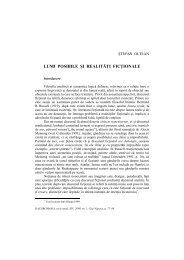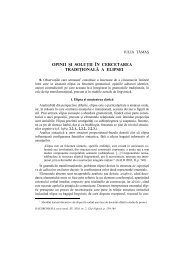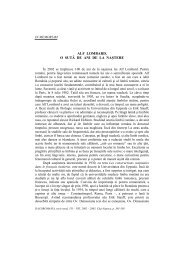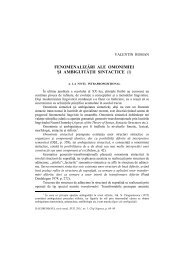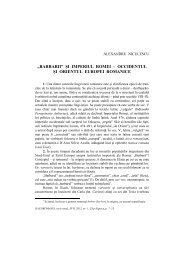norme de prezentare a mauscriselor la revista „dacoromania”
norme de prezentare a mauscriselor la revista „dacoromania”
norme de prezentare a mauscriselor la revista „dacoromania”
You also want an ePaper? Increase the reach of your titles
YUMPU automatically turns print PDFs into web optimized ePapers that Google loves.
RULES FOR THE SUBMISSION OF MANUSCRIPTSStudies and articles sent for publishing must not exceed 30 000 characters (b<strong>la</strong>nksinclu<strong>de</strong>d), notes inclu<strong>de</strong>d; longer text are accepted only exceptionally; it is recommen<strong>de</strong>dthat the texts not to be continued in the following number. We sugest that texts be sent asattachments to the editing staff e-mail address or on CD (stick), written with font size 11,in MS WORD for WINDOWS (or other compatible editing programes); please do notcomputer-edit the text beforehand. The title of the text will be written in CAPS, above thetitle, on the right, using the same type of fonts, the author’s (authors’) NAME andSURNAME. When the article has paragraphs, the numbers indicating them will bewritten in bold, including the fullstop after the figure.The notes will be written in font size 9, as footnotes, numbered sequentially. Inthe first note indicate, if it is the case, the congress/communication/conference where thearticle was previously presented and also the research project it belongs to.The reviews and book presentations will not exceed, as a rule, 8 000 and,respectively, 4000 characters (b<strong>la</strong>nks inclu<strong>de</strong>d), font size 9. They will be presented asfollows: the author’s or editor’s name, the coordinator (followed, for the <strong>la</strong>st one, by themention (ed.) or (coord.) in CAPS, followed by a comma; the title of the book (and, if itis the case, the subtitle, separated from the title by a fullstop), in italics, followed by acomma; the volume (if it is the case), followed by a comma; the number of pages, maps,etc. If the subject of the review/presentation is a periodical publication, the title will bewritten in between inverted commas, not un<strong>de</strong>rlined.Each article will have an abstract (approximately 2 000 characters, with b<strong>la</strong>nks),in English; an abstract in French, German, Italian or Spanish can be also ad<strong>de</strong>d to this;the articles in foreign <strong>la</strong>nguages will have an abstract in Romanian. At the end of theabstract will be ad<strong>de</strong>d the key-words (5) in Romanian and English.At the end of the article, after the abstract and the key-words, will be written, initalics, the institution and the author’s address, including his/her e-mail address.The bibliographic references in notes or in the text will be written in the followingor<strong>de</strong>r: the autor’s (or authors’) name and surname, normal fonts (only the initials in caps),followed by a comma; the title of the book (and the subtitle, separated from the title by afullstop), in italics, followed by a comma; the edition, the edition manager, preface,notes, etc. (if it is the case), fullstop after the title (and subtitle), and initials in caps; thevolume (and/or part), in Roman numbers; comma between the title and the volume; if thevolume has a title itself, a fullstop will be written before it (after the title of the book andthe volume) and after the title of the volume, a comma; publishing p<strong>la</strong>ce, completelywritten, normal fonts (except for the initial), followed by a comma; publishing house,followed by a comma; issue year, completely written, in arabic numbers, followed by acomma; page, marked by p., followed by arabic (or Roman) numbers. For studiespublished in periodical publications, the or<strong>de</strong>r is the following: the author’s name andsurname, in normal fonts (except the initials), followed by a comma; the title of thearticle, in italics, followed by a comma; the indication „in”, followed by the title of theperiodical publication, in-between inverted commas (or just the abbreviation); the issueyear in Roman numbers only, followed by a comma; the calendar year, in arabicnumbers, followed by a comma; the number, if it is the case, (prece<strong>de</strong>d by the indication
nr.), in arabic numbers, followed by a comma; page/pages. If the title (of the book orarticle) has, in its turn, another title or words that need marking, they will be marked withbold and italic. For the studies published in homage or collective volumes etc., after theindication „in” there will be written the title of the respective volume, in italics; if thevolume quoted is entirely the author’s, after „in” there will be written i<strong>de</strong>m; at the end ofthe note, fullstop. There shouldn’t be used, neither in the text, not in notes, theabbreviation „v.” for „vezi” (see); there also shouldn’t be used neither in the text, nor innotes, abbreviations of „i<strong>de</strong>m” (used only to rep<strong>la</strong>ce the author’s or authors’ names) and„ibi<strong>de</strong>m” (used as a synonim of „in the same p<strong>la</strong>ce”); „quoted p<strong>la</strong>ce” will be abbreviatedloc. cit., in italics; supra, infra, passim written in italics; s.v. (= sub voce) in normalfonts, without b<strong>la</strong>nks; „quoted work” and „quoted article” abbreviated op. cit. (not o.c.),art. cit., in italics.If biblioghraphical abbreviations are used (in notes and bibliography), these canbe exp<strong>la</strong>ined either in a footnote, or at the end of the article text, before the abstract andnotes, prece<strong>de</strong>d by the indication, in caps, BIBLIOGRAPHICAL ABBREVIATIONS, orBIBLIOGRAPHY. If bibliographycal abbreviations are used at the end of the article, theywill respect the following rules: the abbreviation will contain the author’s name, followedby the year of the book’s or article’s issue, then the sign =, after that, the bibliographicalreference, according to the above-mentioned rules (not repeating the issue year,obviously). For the bibliographical references in the infra-page notes or in the text, anyother way of symplifying (sigles, figures, etc.) can be used, on condition it is unitary andconsistent; in this case, the sigles and/or the abbreviations will be listed at the end of thearticle. If giving a list of Bibliographical abbreviations or a Bibliography is notconsi<strong>de</strong>red necessary, a study can be truncatedly quoted, but, in this case, after the firstquotation, the truncation will be given between parantheses.The maps, graphs, schemes, drawings and tables will be done in Corel Draw orsent in PDF format.The time limits for sending the manuscripts to the editorial staff are: December 1for number 1 of the following year, respectively March 2 for the second number of thesame year. Dacoromania is a publication that resorts to peer reviewing, each articlereceived for publication being read by two reviewers appointed by the editing board. Inthree months after receiving the material, the editing staff will inform the authors whetheror not the the article has been retained for publication. The unpublished manuscripts arenot returned to the authors.2



